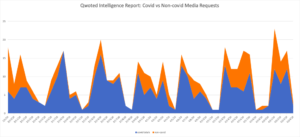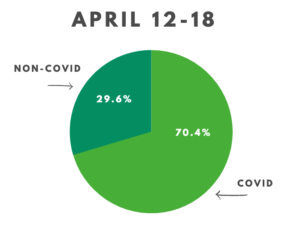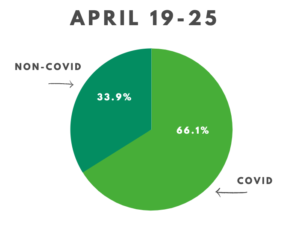A month ago, we sat down with three reporters to discuss how the media landscape has changed throughout COVID-19. At the time, hospitalizations and mortality rates were on the rise, as was the cadence of coronavirus stories.
As the virus and its effects change rapidly, subsequent coverage follows suit. Proprietary data from our sister company Qwoted shows the percentage of COVID-19-related stories declining from mid-March to mid-April, mirroring the reduction in the number of infections and new hospitalizations in recent weeks.
Below is a week by week breakdown of the percentage of stories submitted to Qwoted that were COVID-related. The blue represents COVID-related pitches, where the red represents non-COVID-related pitches.

To make this data a bit clearer, we’ve broken it down by week below:



Percentage of previous COVID-related pitches in Qwoted:
March 29-4: 68.3%
March 22-28: 86.2%
March 15-21: 86.7%
While news organizations are still heavily covering the virus from a health and wellness angle, we’ve seen some new topical trends emerging:
- COVID 2019 and the election: There has been a substantial increase in the percentage of stories that tackle the implications of COVID-19 on the upcoming elections.
- Reopening economies: With states such as Georgia, Texas, Colorado among others partially restarting their economies, publications seem to be grappling with the economics vs. epidemiology trade-offs.
- COVID-19 and data privacy: With Google and Apple teaming up to develop a contact tracing app, questions regarding violations of data privacy are top of mind for technology publications.
Newsrooms are also covering the challenges of frontline workers, according to CNN Business General Manager and VP Jason Farkas.
“One of the things we’re trying to get a better sense of is what challenges frontline workers are encountering. It’s certainly difficult to report that on the front lines as it does become a safety concern for everyone. Because you can’t go to the Amazon warehouse, we’re finding new ways to get at those angles,” he told media news website Talking Biz News.
We’ll continue to monitor the ever-changing news cycle and share trends as they emerge. As always, we hope you and your team find this helpful and would be curious to hear any additional thoughts or experiences you’ve had in working with reporters during COVID-19.


